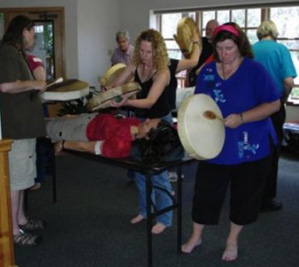


Drum therapy is an ancient approach that uses rhythm to promote healing and self-expression. From the shamans of Tuva to the Minianka healers of West Africa, therapeutic rhythm techniques have been used for thousands of years to create and maintain physical, mental, and spiritual health. Current research is now verifying the therapeutic effects of ancient rhythm techniques. Recent research reviews indicate that drumming accelerates physical healing, boosts the immune system and produces feelings of well-being, a release of emotional trauma, and reintegration of self.
Other studies have demonstrated the calming, focusing, and healing effects of drumming on Alzheimer's patients, autistic children, combat veterans, emotionally disturbed teens, recovering addicts, trauma patients, and prison and homeless populations. Study results demonstrate that drumming is a valuable treatment for stress, fatigue, anxiety, addiction, hypertension, asthma, chronic pain, arthritis, heart disease, mental illness, cancer, multiple sclerosis, Parkinson's disease, stroke, emotional disorders, and a wide range of physical disabilities. Research studies mentioned below indicate that drumming:
Drumming induces deep relaxation, lowers blood pressure, and reduces stress. Stress, according to current medical research, contributes to nearly all disease and is a primary cause of such life-threatening illnesses as heart attacks, strokes, and immune system breakdowns. A 2003 study found that a program of group drumming helped reduce stress and employee turnover in the long-term care industry and might help other high-stress occupations as well.(n1) A groundbreaking 2005 study demonstrated that group drumming not only reduces stress, but reverses genetic switches that turn on the stress response believed responsible in the development of common diseases.(n2)
Chronic pain has a progressively draining effect on the quality of life. Researchers suggest that drumming serves as a distraction from pain and grief. Moreover, drumming promotes the production of endorphins and endogenous opiates, the bodies own morphine-like painkillers, and can thereby help in the control of pain.(n3) Endorphins are among the brain chemicals known as neurotransmitters, which interact with the opiate receptors in the brain to reduce our perception of pain and act similarly to drugs such as morphine and codeine. In contrast to the opiate drugs, however, activation of the opiate receptors by the body's endorphins does not lead to dependence or addiction. Although more research needs to be done, endorphins are believed to produce four key effects on the body/mind: they relieve pain, reduce stress, enhance the immune system, and postpone the aging process.
A 2001 medical research study indicates that drumming circles boost the immune system. Led by renowned cancer expert Barry Bittman, MD, the study demonstrates that group drumming actually increases cancer-killing cells, which help the body combat cancer as well as other viruses, including AIDS. According to Dr. Bittman, "Group drumming tunes our biology, orchestrates our immunity, and enables healing to begin. It's simply a matter of letting go, joining in and having fun -- Mind Over Matter!"(n4)
By helping people express their emotions, music therapy appears to be an effective treatment for depression. Twice a week, with the help of trained music therapists, the participants in a 2011 research study learned how to improvise music using a mallet instrument, a percussion instrument or an acoustic, West African djembe drum. Study results demonstrated that participants receiving active music therapy in addition to standard care had a significantly greater improvement in their symptoms than those receiving standard care alone after three months of treatment.(n5)
Research has demonstrated that the physical transmission of rhythmic energy to the brain synchronizes the two cerebral hemispheres. When the logical left hemisphere and the intuitive right hemisphere begin to pulsate in harmony, the inner guidance of intuitive knowing can then flow unimpeded into conscious awareness. The ability to access unconscious information through symbols and imagery facilitates psychological integration and a reintegration of self. Drumming also synchronizes the frontal and lower areas of the brain, integrating nonverbal information from lower brain structures into the frontal cortex, producing "feelings of insight, understanding, integration, certainty, conviction, and truth, which surpass ordinary understandings and tend to persist long after the experience, often providing foundational insights for religious and cultural traditions."(n6)
The reason rhythm is such a powerful tool is that it permeates the entire brain. Vision for example is in one part of the brain, speech another, but drumming accesses the whole brain. The sound of drumming generates dynamic neuronal connections in all parts of the brain even where there is significant damage or impairment such as in Attention Deficit Disorder (ADD). According to Michael Thaut, director of Colorado State University's Center for Biomedical Research in Music, "Rhythmic cues can help retrain the brain after a stroke or other neurological impairment, as with Parkinson's patients..." The more connections that can be made within the brain, the more integrated our experiences become.
Rhythmic drumming induces altered states, which have a wide range of therapeutic applications. A recent study by Barry Quinn, Ph.D. demonstrates that even a brief drumming session can double alpha brain wave activity, dramatically reducing stress.(n7) The brain changes from Beta waves (focused concentration and activity) to Alpha waves (calm and relaxed), producing feelings of euphoria and well-being. Alpha activity is associated with meditation, shamanic trance, and integrative modes of consciousness. This ease of induction contrasts significantly with the long periods of isolation and practice required by most meditative disciplines before inducing significant effects. Rhythmic stimulation is a simple yet effective technique for affecting states of mind.
In a society in which traditional family and community-based systems of support have become increasingly fragmented, drumming circles provide a sense of connectedness with others and interpersonal support. A drum circle provides an opportunity to connect with your own spirit at a deeper level, and also to connect with a group of other like-minded people. Group drumming alleviates self-centeredness, isolation, and alienation. According to music educator and leadership consultant Ed Mikenas, "Drumming provides an authentic experience of unity and physiological synchronicity. If we put people together who are out of sync with themselves (i.e., diseased, addicted) and help them experience the phenomenon of entrainment, it is possible for them to feel with and through others what it is like to be synchronous in a state of preverbal connectedness."(n8)
Rhythm and resonance order the natural world. Dissonance and disharmony arise only when we limit our capacity to resonate totally and completely with the rhythms of life. The origin of the word rhythm is Greek meaning "to flow." We can learn to flow with the rhythms of life by simply learning to feel the beat, pulse, or groove while drumming. When drummers feel this rhythmic flow, especially at a slower, steady beat, they can shift into a state of deep relaxation and expanded awareness. It is a way of bringing the essential self into accord with the flow of a dynamic, interrelated universe, helping us feel connected rather than isolated and estranged.(n9)
Shamanic drumming directly supports the introduction of spiritual factors found significant in the healing process. Drumming and Shamanic activities produce a sense of connectedness and community, integrating body, mind and spirit. According to research published in the American Journal of Public Health, "Shamanic activities bring people efficiently and directly into immediate encounters with spiritual forces, focusing the client on the whole body and integrating healing at physical and spiritual levels. This process allows them to connect with the power of the universe, to externalize their own knowledge, and to internalize their answers; it also enhances their sense of empowerment and responsibility. These experiences are healing, bringing the restorative powers of nature to clinical settings."(n10)
Drumming can help people express and address emotional issues. Unexpressed feelings and emotions can form energy blockages. The physical stimulation of drumming removes blockages and produces emotional release. Sound vibrations resonate through every cell in the body, stimulating the release of negative cellular memories. As a counselor of at-risk youth, Ed Mikenas finds that, "Drumming emphasizes self-expression, teaches how to rebuild emotional health, and addresses issues of violence and conflict through expression and integration of emotions." Michael Winkelman, a leader in neurotheological perspectives on shamanism, believes that drumming and other shamanic altered states of consciousness activities can also address the emotional needs of addicted populations. In his 2003 article, "Drumming Out Drugs," Winkelman concluded that, "Drumming circles have important roles as complementary addiction therapy, particularly for repeated relapse and when other counseling modalities have failed."(n11)
Drumming helps alleviate stress that is created from hanging on to the past or worrying about the future. When one plays a drum, one is placed squarely in the here and now. One of the paradoxes of rhythm is that it has both the capacity to move your awareness out of your body into realms beyond time and space and to ground you firmly in the present moment. It allows you to maintain a portion of ordinary awareness while experiencing non-ordinary awareness. This permits full recall later of the visionary experience.
Drumming helps reconnect us to our core, enhancing our sense of empowerment and stimulating our creative expression. Music educator Ed Mikenas believes that, "the advantage of participating in a drumming group is that you develop an auditory feedback loop within yourself and among group members -- a channel for self-expression and positive feedback -- that is pre-verbal, emotion-based, and sound-mediated."(n12) Each person in a drum circle is expressing themselves through his or her drum and listening to the other drums at the same time. "Everyone is speaking, everyone is heard, and each person's sound is an essential part of the whole."(n13) Each person can drum out their feelings without saying a word, without having to reveal their issues. Group drumming complements traditional talk therapy methods. It provides a means of exploring and developing the inner self. It serves as a vehicle for personal transformation, consciousness expansion, and community building. The primitive drumming circle is emerging as a significant therapeutic tool in the modern technological age. To learn more, click on the "Articles" link to read informative articles on drum therapy and shamanic drumming.
References:
1. Bittman, M.D., Barry, Karl T. Bruhn, Christine Stevens, MSW, MT-BC,
James Westengard, Paul O Umbach, MA, "Recreational Music-Making, A Cost-Effective Group
Interdisciplinary Strategy for Reducing Burnout and Improving Mood States in Long-Term
Care Workers," Advances in Mind-Body Medicine, Fall/Winter 2003, Vol. 19 No.
3/4.
2. Barry Bittman, Lee Berk, Mark Shannon, Muhammad Sharaf, Jim
Westengard, Karl Guegler, David Ruff, "Recreational music-making modulates the human
stress response: a preliminary individualized gene expression strategy," Medical
Science Monitor, 2005; 11(2):BR31-40.
3. Winkelman, Michael, Shamanism: The Neural Ecology of Consciousness
and Healing. Westport, Conn: Bergin & Garvey; 2000.
4. Bittman, M.D., Barry, "Composite Effects of Group Drumming...,"
Alternative Therapies in Health and Medicine; Volume 7, No. 1, pp. 38-47; January
2001.
5. Erkkila J, Punkanen M, Phil L et al. "Individual music therapy for
depression: randomised controlled trial," The British Journal of Psychiatry
2011.
6. Winkelman, Michael, Shamanism: The Neural Ecology of Consciousness
and Healing. Westport, Conn: Bergin & Garvey; 2000.
7. Friedman, Robert Lawrence, The Healing Power of the Drum. Reno, NV:
White Cliffs; 2000.
8. Mikenas, Edward, "Drums, Not Drugs," Percussive Notes. April
1999:62-63.
9. Diamond, John, The Way of the Pulse - Drumming with Spirit,
Enhancement Books, Bloomingdale IL. 1999.
10. Winkelman, Michael,
"Complementary Therapy for Addiction: Drumming Out Drugs," American Journal of Public
Health; Apr 2003, Vol. 93 Issue 4, p647, 5p.
11. Winkelman, Michael, "Complementary Therapy for Addiction: Drumming
Out Drugs," American Journal of Public Health; Apr 2003, Vol. 93 Issue 4, p647,
5p.
12. Mikenas, Edward, "Drums, Not Drugs," Percussive Notes. April
1999:62-63.
13. Friedman, Robert Lawrence, The Healing Power of the Drum. Reno, NV:
White Cliffs; 2000.
Preview our Digital Books and Music
Affiliate disclosure: As an Amazon Associate, we earn from qualifying purchases. You can learn more about our editorial and affiliate policy here. Music Attribution.
© 2001 - 2025 Talking Drum Publications